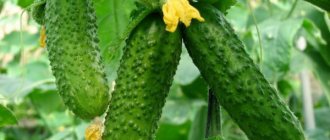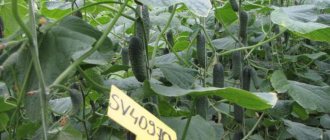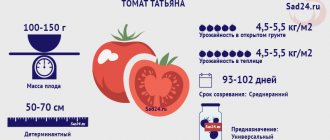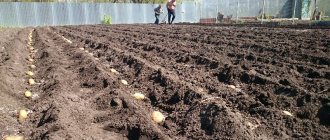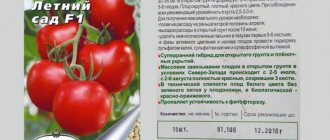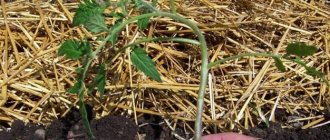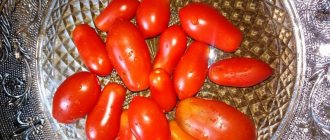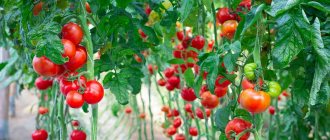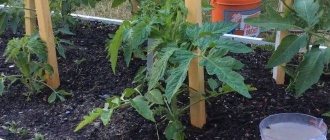The history of the origin of the Alvara potato variety
The Alvara potato variety is the result of the work of German breeders - brothers Frank and Winfried Lange.
In 1975, by crossing two mother tubers and 10 years of stepwise selection, one root crop was obtained that passed all tests.
In 1985, the Alvara variety received state registration in Germany. "Alvara" is included in the State Register of Russia , zoned for cultivation in the North-Western and North Caucasus regions.
The table presents data on the mass of marketable tubers (grams) of different varieties:
| Name | Variety | Weight |
| Nikulinsky | Late ripening | From 70 to 120 |
| Cardinal | Late ripening | 65-110 |
| Rocco | Late ripening | 100-120 |
| Picasso | Late ripening | 80-140 |
| Borovichok | Early ripening | 120-200 |
| Elmundo | Early ripening | 120 |
| Felox | Early ripening | From 100 to 120 |
| Bellarosa | Early ripening | From 120 to 210 |
| Karatop | Extra early | From 58 to 100 |
| Zhukovsky early | Extra early | 100 to 120 |
| Farmer | Extra early | From 90 to 110 |
| Minerva | Extra early | From 120 to 245 |
| Sorcerer | Mid-late | From 75 to 120 |
| Mozart | Mid-late | From 100 to 150 |
| Grenada | Mid-late | From 800 to 100 |
| Melody | Mid-late | From 95 to 180 |
| Giant | Mid-early | 100-140 |
| Tuscany | Mid-early | From 90 to 125 |
| Purple Haze | Mid-early | From 90 to 160 |
| Openwork | Mid-early | 90-120 |
general characteristics
Potatoes "Alvara" belong to the mid-early varieties. It was bred by German breeders in 1985. The authors are brothers Winfried and Frank Lange. The variety successfully passed quality tests and very quickly gained popularity among European farmers.
Somewhat later, “Alvara” came to Russia. According to the State Register, the crop is recommended for cultivation primarily in the North-Western and North Caucasus regions.
Reviews from farmers and gardeners about this crop are mostly positive. This root crop can grow and produce a decent harvest on almost any soil. It is this feature that is often cited as a significant advantage.
The variety has the following features and properties:
- The ripening period for root crops is 70-80 days;
- the crop produces a fairly abundant harvest (under optimal conditions, about 500 centners of fruit can be harvested from one hectare of plantings);
- On average, 10-14 tubers are obtained from one bush;
- the variety has high resistance to potato cancer, scab, and golden nematode;
- culture is not subject to cellular degeneration;
- Alvara potatoes are resistant to dry weather and can do without additional watering.
Consider the description of the plant.
- The bushes are relatively tall, erect or semi-erect. They can reach 1.5 meters in height.
- The foliage is small to medium in size, with slight wavy edges. The leaves have a dark green color. The leaf blades are smooth to the touch.
- During the growing season, the crop forms dense and spreading tops.
- The flowers are red-violet in color, collected in medium-sized inflorescences.
Description of fruits:
- potatoes are oval in shape, there are small eyes in the tubers;
- the peel of the fruit is smooth, red in color;
- the pulp has a light yellow color and a granular structure;
- average potato weight is 90-105 g;
- starch content in fruits is within 13-14%;
- the tubers have an attractive presentation and tolerate transportation well;
- keeping quality of fruits – 90%.
We invite you to read the Questions and Answers. Worms and vermicompost Advantages of the variety:
- high productivity;
- unpretentiousness to growing conditions and type of soil;
- the crop can be used for planting season after season, the variety does not degenerate;
- the culture can be cultivated on an industrial scale;
- good transportability and keeping quality of fruits;
- resistance to typical potato diseases and pests.
Flaws:
- relatively high price for the crop and seed material of this variety;
- "Alvara" is susceptible to attacks by fungal diseases and late blight.
Description of the variety
Roots:
- Oval shape of tubers;
- Smooth, red peel;
- Small eyes;
- The pulp is light yellow when cut;
- Average weight up to 110 grams;
- Starch content is no more than 14.1%.
Potato tasting:
Bushes:
- The plant is tall, intermediate type, can be erect or semi-erect;
- The flower corolla varies from small to medium in size and is red-violet in color;
- Leaves are small to medium sized, green in color.
Advantages and disadvantages
Alvara potato variety has the following advantages:
- Formation of a fairly early harvest;
- High productivity;
- Stability of growth;
- The presence of multituberism;
- Excellent quality parameters of potato root vegetables;
- Excellent taste characteristics;
- Resistance to viral diseases such as cancer and nematodes;
- The ability to universally use tubers;
- Suitable for long-term storage with minimal losses;
- The ability to cultivate the variety for a long time without replacing seed material.
In addition to many advantages, it has some disadvantages:
- Quite a high cost of planting tubers;
- The resistance of tubers and tops to late blight is quite low.
Correct fit
At the moment, gardeners are using several technologies for cultivating the Alvara variety simultaneously. Nevertheless, most often, classical or traditional cultivation technology is practiced on personal plots, consisting of the following activities:
- Before planting, it is necessary to carry out pre-planting preparation, which consists of selecting seed material that is suitable in terms of external indicators and quality characteristics;
- Tubers need preliminary germination and heating, after which they are planted in soil heated to +8 - +10 ºС;
REFERENCE: The soil should not only be warmed up, but also slightly moist, crumble well and absolutely not stick to the shovel while digging.
- A good result is observed if you pre-treat the soil using modern herbicides, which significantly reduce the time and effort required for the weeding procedure;
- Early planting of potatoes involves not only deep plowing of the soil, but also adding humus and ash to the planting holes;
- The row spacing should be at least 50-60 cm, and the depth of planting material is determined by the climate and the quality of the soil.
Step-by-step instructions for growing
Inventory
To cultivate potatoes efficiently, you need to use the following tools:
- Shovels. You can replace them with large pitchforks (as you wish).
- Hoses for irrigation (with a drip irrigation system). Large watering cans for manual crop care.
- Rake.
- Hoes.
- Boxes or other containers for storing collected tubers.
- Tarpaulin for drying potatoes in beds.
- Fabric gloves.
- Covering material - agrofibre, to mulch crops to protect them from cold, quickly form seedlings, and prevent areas from being damaged by weeds.
- Mini-harvesters, tractors, potato diggers for growing vegetables in large planting areas.
Important!
The quality of crop care depends on well-chosen equipment.
Preparation
Soils
The soil is dug up in the fall, and the beds are additionally fertilized. Areas for potato planting are selected taking into account the grown predecessor crops. For example, you cannot plant tubers after harvesting nightshades:
- tomatoes;
- peppers;
- other types of potatoes.
The beds are laid out in places where the crops are harvested:
- Cabbage.
- Bobovykh.
- Winter crops.
- Sideratov.
- Ogurtsov.
- Garlic.
- Luke.
- Kabachkov.
The Alvara variety Excellent potatoes are obtained from:
- sod-podzolic;
- clayey;
- sandy;
- gray;
- brown;
- peat-gel soils.
- In spring, it is recommended to plow the plots deeply again and add humus or wood ash to the planting holes. As a fertile replenishment, the beds are fertilized with peat.
- Preliminary treatment of the soil with herbicides will prevent infection of the site by weeds, pests, viruses, reduce the number of weedings, and simplify crop care.
- Before planting, the soil must be warmed up and slightly moistened. It is necessary that the soil crumbles slightly, but does not stick to the shovel during digging.
Planting material
Preparing tubers for planting consists of several stages:
- potato sorting;
- germination;
- preheating;
- treatment with fungicides, growth stimulants, disinfectant solutions.
About a month before planting, seed potatoes are transferred to a bright and warm room. At the same time, do not forget about high-quality ventilation. Tubers are germinated at a temperature of +20 degrees. A day before sowing, vegetables are treated with disinfectants, growth stimulants, fungicides, and dried. For hardening, they are taken outside the day before planting.
Advice
Before planting, the tubers are slightly warmed up, but it is necessary to monitor the length of the sprouts so that they do not grow above 2–3 cm, so that they do not break off when planted in the holes.
Boarding time
Before starting planting work , it is necessary that the soil warms up from +8 to +10 degrees. Planting dates directly depend on weather conditions and differ in different regions. Work approximately begins:
- From the end of April - in the south.
- In mid-May - in the Moscow region and in the central zone of the Russian Federation.
- From late spring - early June - in the Urals and Siberia.
Scheme
The distance between rows is 65–70 cm. In each strip, the space between planting holes should be 35 cm. The depth of planting of tubers depends on climatic conditions and soil structure. On average, this figure is 8–10 cm.
Care
Hilling
Raking the soil under the bushes at the initial stage of growth protects the crops from return frosts that may occur on the ground during early planting. Hill up for the first time when the potato tops reach 17–20 cm in height. After 2 weeks, the procedure must be repeated. Hilling is carried out immediately after watering, so that the soil is slightly moist.
A well-performed procedure is a source of increasing potato yields. Hilling is not recommended in dry climates.
Watering
“Alvara” is a drought-resistant variety, but this does not mean that such potatoes do not need watering. Irrigation should be rare but plentiful. Particular attention is paid to soil moisture during the growing season of crops.
Advice
The soil layer is soaked to a depth of 40–50 cm. The water consumption rate is approximately 12 liters for each bush.
Loosening
Soil aeration is necessary for:
- strengthening roots;
- weed removal;
- improving crop growth;
- simplifying care.
Work begins after all potato shoots appear. Be sure to loosen, combined with weeding, after watering, fertilizing, as necessary. With proper agricultural technology, most often, the procedure is carried out three times per season.
Weeding
It is necessary to regularly clear the beds of weeds throughout the entire potato growing season. The work is carried out in conjunction with loosening between rows.
Top dressing
The Alvara variety is responsive to uniform application of fertilizers. Fertilizing with organic and mineral substances will be especially useful for crops. You should not overdo it with nitrogen-containing fertilizers; it is better to stop such fertilizing altogether after budding in order to prevent strong growth of tops and not to slow down the formation of tubers.
During the season, potatoes are fertilized in three stages:
- During the initial growth of the tops, a solution of urea (5 g per 10 liters of water), mullein (0.5 slurry is mixed in 10 liters of water) or bird droppings (500 g is mixed in 10 liters of water, then diluted 1 part) is added under the bushes. 10).
- During the budding period , add wood ash (180 g of the substance is dissolved in 10 liters of water), potassium sulfate (30 g of the substance is diluted in 10 liters of water).
- At the flowering stage, superphosphates are used (40 g of the substance is diluted in 10 liters of water) or nitrophoska (approximately 30 g per 10 liters).
Fertilizer consumption is 0.5 liters for each potato bush.
Other care measures
Mulching plantings is an effective way to protect bushes from frost during cold snaps.
Advice
By covering potato plantations with peat, straw or grass bedding, experienced farmers simplify crop care, reduce the amount of necessary watering, and prevent diseases.
Care
The Alvara potato variety is quite unpretentious and guarantees a good harvest even with insufficient proper care. To form a full harvest of tubers with high marketability, you must follow the following care recommendations:
- Hill up potato plantings in a timely manner in the initial growth phase, this will protect them from the effects of age-related spring frosts. The first time they hill up when the potato tops reach a height of 15-20 cm, the second time they hill up after two weeks;
- The first time fertilizer is applied during the growth period of the tops, using urea and mullein or bird droppings. The second time is fed during the budding period, using potassium sulfate and wood ash. The third feeding with superphosphate and nitrophoska is carried out in the flowering phase;
- Watering potato plantings should be quite rare, but plentiful;
- During the entire growing season, remove weeds in a timely manner, and then superficially loosen the soil between the rows.
REFERENCE: The soil should be wetted by 0.4-0.5 m or from the ratio of 12 liters of water for each bush.
How to care for potatoes
Alvara's care is standard. It includes watering, fertilizing, loosening, weeding, hilling and preventive treatment.
Irrigation mode
The Alvara potato variety is drought resistant. It does not need frequent watering; it is enough to do it several times a season, more often in the southern regions. The signal for irrigation is when the soil dries out by 6–8 cm. In wet weather there is no need to water.
Although Alvara is watered rarely, it is plentiful. In hot summers, you may need half a bucket of water for each adult bush.
It is very important that plants are hydrated during flowering and tuber formation.
Feeding
Potatoes growing on fertile soil and fertilized during planting do not need further feeding.
But if there is a need, you can feed it during the growing season:
- during the growth of greenery - nitrogen mineral fertilizer (urea solution) or organic (mullein or chicken manure solution);
- during the budding period, before the start of flowering - phosphorus-potassium fertilizer (superphosphate with potassium sulfate and wood ash).
We recommend that you learn what and how to properly process potatoes.
Next, you can apply foliar feeding by spraying the bushes:
- after the start of flowering - a solution of ammonium nitrate, superphosphate and potassium chloride;
- during the growth of root crops - with a special fertilizer "Mag-Boron", containing magnesium and boron, which improve the taste and density of tubers.
Weeding and loosening the soil
The first loosening of the soil should be carried out even before the emergence of seedlings, about a week after planting. This measure will ensure air access to the planted seeds. You can loosen the soil while simultaneously removing germinating weeds with a rake or harrow.
Subsequently, these operations are carried out the next day after each watering and rain. Don't forget about hilling. The first time plants are 15–20 cm high, and again after 2 weeks. But in the southern regions, where there is little moisture in the ground, there is no need to hill up the bushes.
Read more about why hilling potatoes is needed.
Preventive treatment against diseases and pests
Alvar potatoes have strong immunity. Of all potato diseases, only late blight is susceptible.
Prevention from the disease is the following steps:
- compliance with crop rotation;
- planting only germinated seeds;
- treatment with special preparations before planting;
- compliance with the correct planting scheme so that the bushes are well ventilated and illuminated;
- in humid weather favorable for late blight, preventive spraying with fungicides (copper oxychloride, Modex, Azocene 5%, Polycarbacin 80%, Arcerid 60%).
The most dangerous pest is the Colorado potato beetle. Old and young individuals can destroy a potato planting in a few days. A preventive measure is to treat the tubers before planting. And you can fight the beetles that have already appeared by spraying the bushes immediately after the larvae hatch. Insecticides used: “Prestige”, “Aktara”, “Regent”, “Korado”.
Important! The last spraying with chemicals should be carried out no later than 20 days before harvest
Diseases and pests
The main enemies of potatoes include the Colorado potato beetle. There are two effective ways to combat pests:
- Carrying out pre-planting treatment of planting material in a special solution that will protect potato plantings for 40-60 days;
- Treat the stems with pesticides during the growth phase of the crop.
ATTENTION: With this method, they are processed immediately after the larvae hatch.
Alvara potatoes have good immunity to most diseases and pests, but are susceptible to late blight.
We invite you to familiarize yourself with potato varieties that have different ripening periods:
| Late ripening | Early ripening | Very early | Mid-late | Mid-early |
| Nikulinsky | Borovichok | Forty days | Crane | Yanka |
| Cardinal | Elmundo | Karatop | Sorcerer | Giant |
| Rocco | Felox | Riviera | Mozart | Tuscany |
| Kiwi | Bellarosa | Zhukovsky early | Grenada | Purple Haze |
| Ivan da Marya | Natasha | Farmer | Melody | Openwork |
| Picasso | Ariel | Minerva | Margarita | Santana |
| Asterix | Queen Anne | Veneta | Ramona | Desiree |
| Slav | Arosa | Kiranda | Dolphin | Lady Claire |
To prevent the disease, the following preventive measures are recommended:
- Germinate seed before planting;
- Alternate potato plantings with other crops;
- Treat the soil with the following preparations: Azocene 5%, Modex, Polycarbacin 80%.
REFERENCE: The last time is processed no later than three weeks before harvesting.
Harvest and storage
Potatoes are harvested in late August - early September. By this time, the tops usually lie down and dry out. If the stems are still green, they need to be mowed 2 weeks before harvesting. This will speed up the ripening of root vegetables and the hardening of the skin. Digging up potatoes of this variety is quite convenient, since the tubers in the nests are compact. The harvested crop must be dried in air for several hours.
Then the root crops need to be sorted into large, small, damaged and seeded. First of all, you will need to use damaged potatoes, then small ones. The sorted potatoes are put into boxes and put into the cellar. The storage temperature should be +2...+4°C and humidity 90–92%.
You may be wondering if you need to wash your potatoes before storing them.
In such conditions, tubers can last even until a new harvest, remaining beautiful and tasty. Many gardeners have been growing Alvar potatoes on their plots for many years. They prefer it to other varieties for its unpretentiousness, stability and good taste.
Reviews about the variety
The Alvara potato variety is one of the best varieties of European selection among varieties with red skin and yellow flesh. The tubers do not become overcooked and do not darken during cleaning or heat treatment. Alvara potatoes are characterized by stable productivity, even on infertile soils, as evidenced by numerous reviews from domestic and foreign gardeners.
To grow a mid-early potato variety that will provide a rich harvest on any type of soil and is resistant to diseases, you should pay attention to the Alvara potato. It is excellent for cultivation in the climatic conditions of Russia.
History of selection
The Alvar potato was developed in 1985 by the German company Saatzucht Fritz Lange KG, which has been breeding seed potatoes for a long time. The Lange brothers worked on the selection of this variety. They wanted to create a mid-early potato variety with characteristics superior to its predecessors.
Did you know? Potatoes are native to South America. In 1580, the vegetable was brought to Europe, and it came to North America 40 years later, although it is geographically closer.
After 10 years of painstaking work, they received a tuber that passed all tests and met all the requirements: productive, unpretentious to the soil, resistant to drought and disease, high-quality root crops with excellent taste. In 1999, Alvara was included in the State Register of Russia with permission to cultivate in the North-West and North Caucasus regions. But it is actively grown almost throughout the country, as well as in Ukraine and Belarus.

